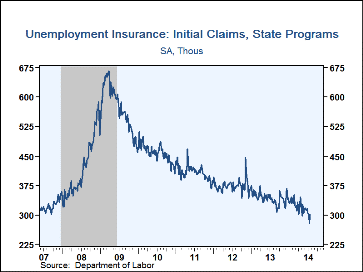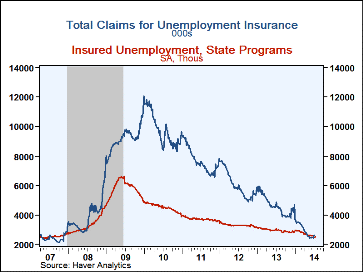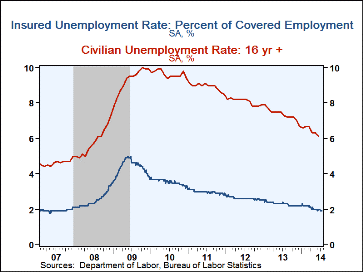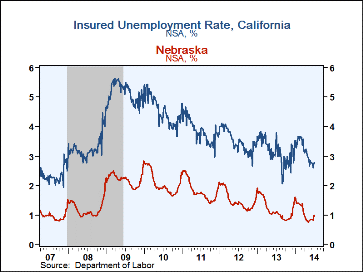 Global| Jul 31 2014
Global| Jul 31 2014U.S. Initial Unemployment Insurance Claims Recoup Earlier Decline
by:Tom Moeller
|in:Economy in Brief
Summary
Initial unemployment insurance claims rebounded to 302,000 (-9.3% y/y) during the week ended July 26 from 279,000 in the week prior, earlier reported as 284,000. The four-week moving average of initial claims, nevertheless, fell to [...]
Initial unemployment insurance claims rebounded to 302,000 (-9.3% y/y) during the week ended July 26 from 279,000 in the week prior, earlier reported as 284,000. The four-week moving average of initial claims, nevertheless, fell to 297,250, the lowest level since April 2006. The latest figure compared to expectations for 302,000 claims in the Action Economics Forecast Survey. During the last ten years there has been a 76% correlation between the level of claims and the m/m change in payroll employment.
Continuing claims for unemployment insurance in the week ended July 19 increased to 2.539 million (-13.9% y/y). Nevertheless, the four-week moving average fell to a new low of 2.535 million. The insured rate of unemployment held at 1.9% for the third straight week. This particular count covers only "regular" programs and does not include all extended benefit and other specialized jobless insurance programs. In the week of July 12, the latest available, the total of all benefit recipients increased to 2.618 million (-44.2% y/y). This broader measure is not seasonally adjusted. It compares to a cycle peak of 12.060 million in January 2010 and pre-recession figures that averaged 2.596 million in 2007. Year-on-year comparisons are impacted by the expiration of the Emergency Unemployment Compensation program at the end of 2013.
By state in the July 12th week, the insured rate of unemployment continued to vary greatly with Nebraska (0.98%), Virginia (1.05%), Louisiana (1.26%), Florida (1.27%), Texas (1.44%) and Vermont (1.55%) at the low end of the range. At the high end were Maryland (2.19%), Illinois (2.44%), Massachusetts (2.52%), California (2.78%), Pennsylvania (2.89%) and New Jersey (3.48%). These data are not seasonally adjusted.
Data on weekly unemployment insurance are contained in Haver's WEEKLY database and they are summarized monthly in USECON. Data for individual states are in REGIONW. The expectations figure is from the Action Economics survey, carried in the AS1REPNA database.
| Unemployment Insurance (000s) | 07/26/14 | 07/19/14 | 07/12/14 | Y/Y % | 2013 | 2012 | 2011 |
|---|---|---|---|---|---|---|---|
| Initial Claims | 302 | 279 | 303 | -9.3 | 343 | 375 | 409 |
| Continuing Claims | -- | 2,539 | 2,508 | -13.9 | 2,977 | 3,319 | 3,742 |
| Insured Unemployment Rate (%) | -- | 1.9 | 1.9 | 2.3 (7/13) |
2.3 | 2.6 | 3.0 |
| Total "All Programs" (NSA) | -- | -- | 2.618 mil. | -44.2 | 4.651 mil. | 6.049 mil. | 7.725 mil. |
Tom Moeller
AuthorMore in Author Profile »Prior to joining Haver Analytics in 2000, Mr. Moeller worked as the Economist at Chancellor Capital Management from 1985 to 1999. There, he developed comprehensive economic forecasts and interpreted economic data for equity and fixed income portfolio managers. Also at Chancellor, Mr. Moeller worked as an equity analyst and was responsible for researching and rating companies in the economically sensitive automobile and housing industries for investment in Chancellor’s equity portfolio. Prior to joining Chancellor, Mr. Moeller was an Economist at Citibank from 1979 to 1984. He also analyzed pricing behavior in the metals industry for the Council on Wage and Price Stability in Washington, D.C. In 1999, Mr. Moeller received the award for most accurate forecast from the Forecasters' Club of New York. From 1990 to 1992 he was President of the New York Association for Business Economists. Mr. Moeller earned an M.B.A. in Finance from Fordham University, where he graduated in 1987. He holds a Bachelor of Arts in Economics from George Washington University.










